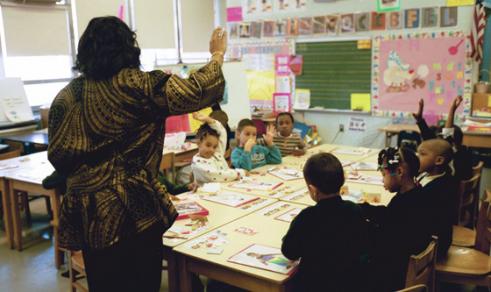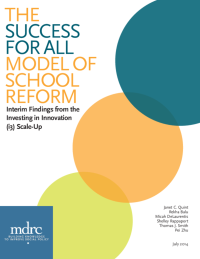Interim Findings from the Investing in Innovation (i3) Scale-Up
The Success for All Model of School Reform

First implemented in 1987, Success for All (SFA) is a whole-school reform initiative whose goal is to help all elementary school students become competent readers. Its key elements include:
- Reading instruction marked by an emphasis on phonics and on comprehension, a highly structured curriculum, use of cooperative learning strategies, across-grade ability grouping,
frequent assessments, and tutoring for students who need extra help - Components that address students’ noninstructional issues
- Strategies to secure teacher buy-in, provide teachers and leaders with initial and ongoing training, and foster shared leadership
SFA was selected to receive a five-year scale-up grant under the U.S. Department of Education’s Investing in Innovation (i3) competition. This, the second of three major reports from MDRC’s independent evaluation of the scale-up effort, discusses the program’s implementation and impacts in 2012-2013, the second year of operations at the study sites. The impact evaluation uses a cluster random assignment design involving 37 schools serving students in kindergarten through grades 5 or 6 (K-5 or K-6) and located in five school districts; 19 schools were randomly selected to receive the SFA program, while the remaining 18 “control group” schools did not receive the intervention. The report considers the experiences of school staff members and compares the reading performance in first grade of a cohort of kindergarten students who remained either in the SFA schools or in the control group schools for two years (and therefore received the maximum program “dosage”).
Key Findings
- During the second year, schools strengthened their implementation of SFA. New program practices were implemented, and the proportion of classrooms within a school where SFA-prescribed practices were in evidence increased. Teachers also reported feeling more comfortable with the program.
- By the end of the second year, 16 of the 19 program group schools were judged to meet the Success for All Foundation’s standards for adequate implementation fidelity.
- SFA reading classes continued to be distinguished from reading classes in the control group schools by greater use of cooperative learning, more extensive ability grouping of students, and close adherence to the curriculum. Tutoring, although a key program element, was not implemented more widely in SFA schools than in control group schools.
- First-graders who had been enrolled in SFA schools since kindergarten significantly outperformed their counterparts who had been continuously enrolled in control group schools on two measures of phonetic and decoding skills, although not on measures of fluency and comprehension, which are higher-order reading skills. Impact findings for subgroups of students defined by various demographic characteristics are, for the most part, consistent with the main findings.






